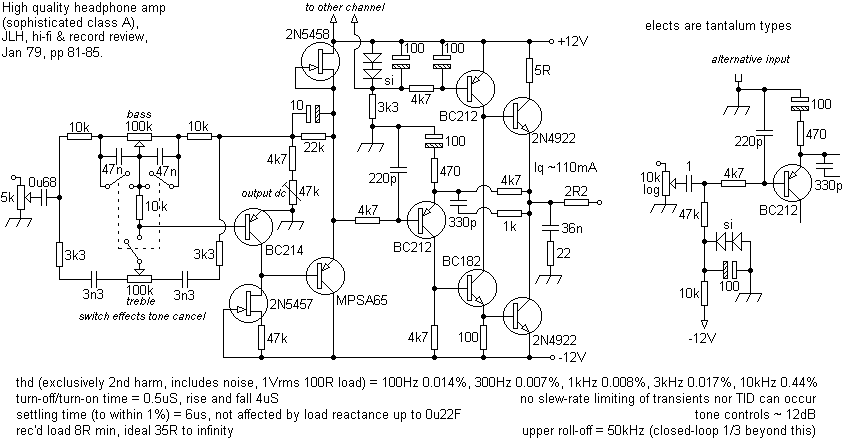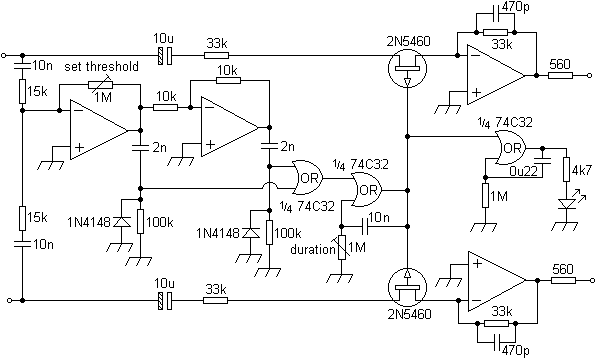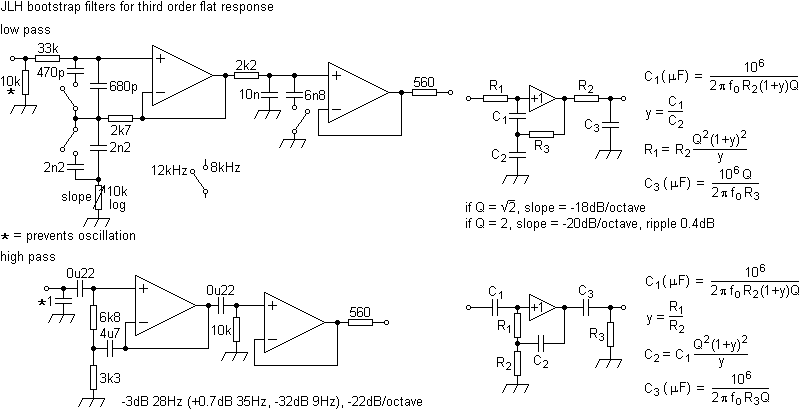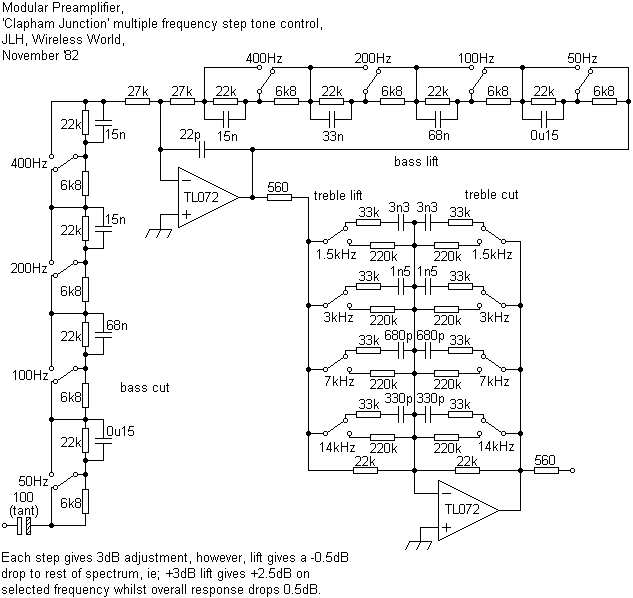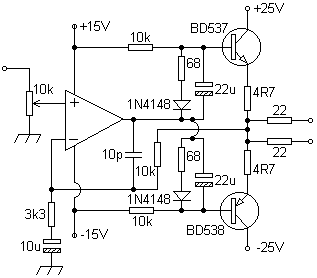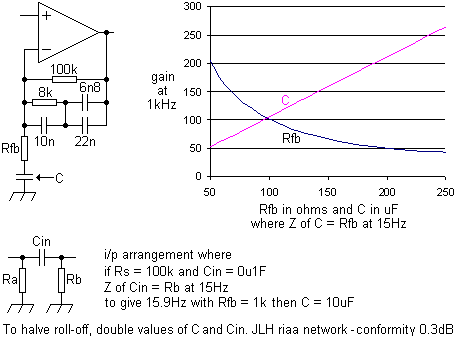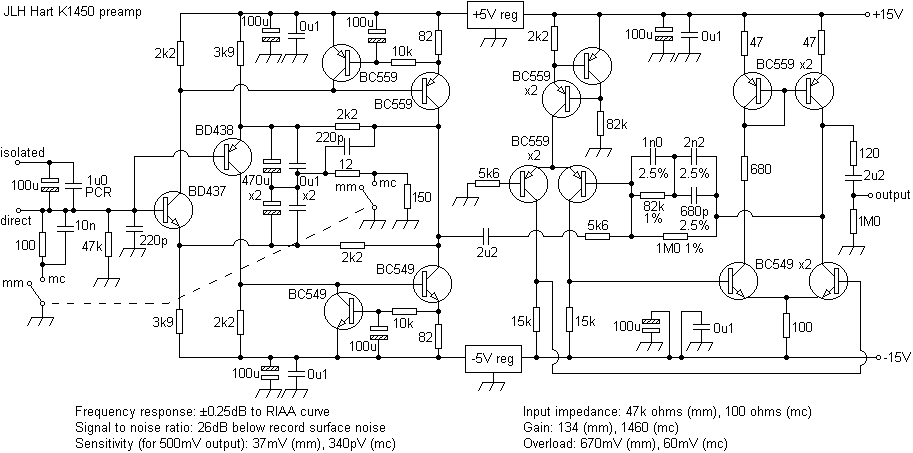John Linsley Hood preamp designs
A versatile and, thankfully, prolific designer John Linsley Hood has educated many with a fresh eye, backed by a much-welcomed and thorough empiricism.
A zip-file of data on JLH's Modular Pre-Amplifier Design (Wireless World article, July 1969), contemporary to the simple class A power amp design published in April of that year (circuit diagram) is available on request.
Below is Linsley Hood's 'Liniac' RIAA stage (WW, Sept '71, data kindly supplied by Cyril Wilkin).

This configuration explored the possibilities utilising low-level Darlington transistors to create inverting high input impedance, high gain, low noise and low distortion building blocks. Other 'flat' approaches included

tone controls
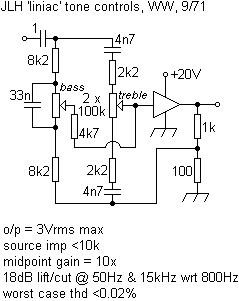
and a low distortion oscillator.
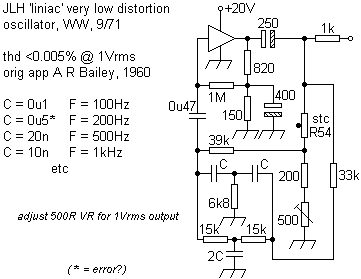
In the same article, attention was paid to other configurations.
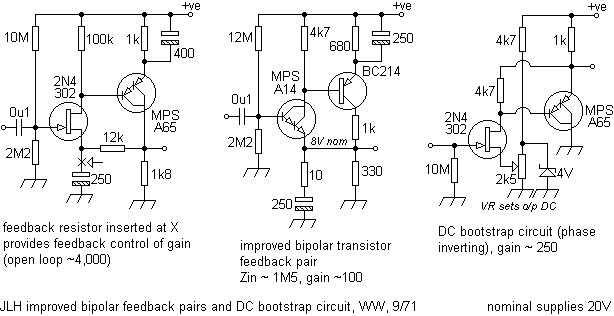
The 75W Powertran kit used a 'Liniac' preamp with a 'mode' switch and switched range tone control with variable slope high filter and switched low filter (PDF available). A later 'Deluxe' version made construction easier with plug-in boards, the power amp used being similar to the improved HiFi News and Record Review (1972?) version and incorporated other improvements like a headphone socket. Heatsinking was limited and some had problems with assembly which could result in accidental gross shorts. Although flexible, with in excess of 25 switch contacts per channel mechanical noise could be problematic, as could mains borne interference despite a steel enclosure and screened mains transformer, notwithstanding the optimistic output rating which had not been intended as a continuous one.
Amongst other designs, this class A headphone amplifier appeared in 1979.
Because of the high quiescent current JLH recommended T03 style regulators (MC7812 CK, MC7912 CK) regulators, smoothed by 1mF and decoupled by 47µF per rail.
The JLH 'ripple eater' is covered adequately by Jon Clancy. This can offer the equivalent of 0.5F smoothing.
Following the Wireless World '80-100W Mosfet Audio Amplifier' (Aug '82), which many found interesting despite some serious errors (corrected in the September '82 issue, p63), the 1982/3 Modular Preamplifier design (another excellent source of food for thought) appeared whose schematics are covered here together with some of the later ones (ETI, etc) marketed as Hart kits. Note that it is recommended that both sides of any coupling capacitors be grounded via high value resistors to prevent switching 'clicks'.
The later design was powered by a conventional 7815/7915 regulated supply. The main intention was that the modules, switched into the signal path as required, would function at a nominal 0.774V, 600R impedance. A virtual earth mixer was used to select the inputs and provide a balance function, the gain pots being ganged. JLH expressed regret at the high impedances used, however, with the DIN convention these are unavoidable.
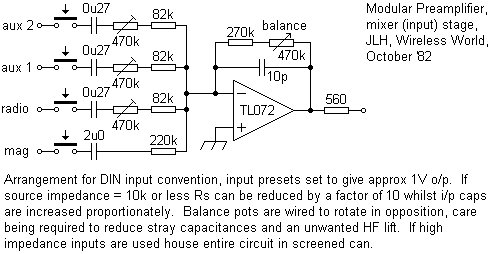
Some designs seen used two sets to accommodate DIN and RCA phono conventions.
This arrangement for a moving-coil buffer has been used with success as a mic preamp and is one of the simplest MC buffer designs seen. Electrolytics can be paralleled with 1µF polycarbs. Switching contacts, if used, should be gold-on-gold. The matching RIAA stage is given below. Remove 1µF output cap if used with this.

Employing a 'series-shunt' two-stage configuration, this approach allows accurate tracking of the RIAA curve with standard value components and an improved upper frequency response, without being over-engineered.
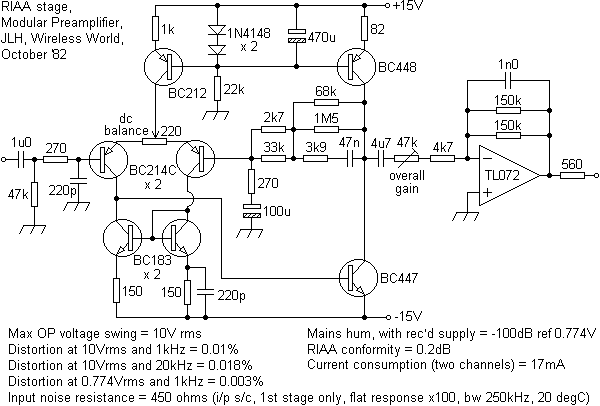
The noise figure of 450 ohms does not refer to the layout shown and if difficulties are encountered sourcing the BC447/BC448 transistors, their JEDEC equivalents are 2N2907A/2N5551.
A combination of one or more of the above is considered adequate for all practical purposes, barring the possible substitution of the opamp. But then there's the more complex discrete version below, if a greater degree of precision is deemed necessary. Some other items of interest from the '82/3 Modular Preamplifier designs;
a microphone preamp,

an image-width module (other designs),
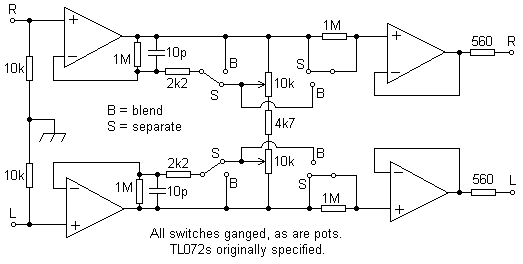
an impulse-noise blanker (useful for scratched vinyl),
Switching contacts, if used, should be gold-on-gold. Ideally matched to a cartridge in it's deck, thus negating use of contacts. The 'isolated' input is intended for moving magnets and the 'direct' one for moving coils. Allow 30mA per rail. If a differential cable run is required, then an IC solution can be argued to perform better than transformers, eg: SSM2142/3 (s/n >105dB, 7MHz). A 100mA supply for a complete stereo solution should suffice.
Vincent Hawtin notes that "... the 2n2 and 680pf amount to 2880pf this time constant should be with the 1meg resistor 2937us thus adding an extra 50 pf to the 2880pf will give 2930us about as close as you can get with standard values John always tried to get as close with easily available parts so 2880 would be near enough but there is a slight improvement with the added 50 pf which reduces the slight mid lift without it the rest of the arrangement is as good as it can get without special values. One other change that was in the K1400 kit was the 12 ohm with the moving coil switch on the I/P amp was increased to 25 ohms to improve the low frequency roll off in the MC position to 14 hz with the switch in the MM position this would be 2.2hz as you can see with 470uf and 12 ohms not so much bass. You can X-check this mod in his book Audio Electronics.. page 126 refers to diagram 1f in preceeding page of networks thus :- 1meg /82k =12.195.......should be 12.38 near enough 82k and 1n = 82us..... should be 81.1us near enough and finally the 2.2+680 with 1 meg =2880us... should be 2937us so adding the 50 pf will do it nicely... ... yes you are quite correct that the values on my cct specify 2.5% tolerance for caps and 1% for resistors and that would certainly take care of the 50 PF extra but when i measured the caps from Hart they were pretty much spot on the values so i presume they went one better and used 1%.. My own design of RIAA using op amps uses 1% tolerance caps and the design is very accurate in the RIAA curve and so i use it to check other manufacturers pre-amps some of which do not sound quite right I believe that with very good amplification smaller errors are noticable.. By the way in the early gain stage the 470 uf caps sent with the Hart kit were NOVO types when these are replaced by the low Z Nichicons this amp takes on a new persona.. Also if you can place a cap of about 0.22 to 0.33uf straight across the 5volt rails + to - that also helps to clean the signal seems to cut some noise from those 5volt regs.."
For the 50pF value, 3 //'d 18pF Philips 683 series (ceramic plate, low K, 2%, 100V, 0ppm/°C) could be used. Regulator noise (typ. 40µV, ripple rejection 60dB for L series) can be overcome by using simple zeners or additional decoupling, however, a simple Armstrong solution can be effective.
Some circuits from the K1400 preamp; a low back-EMF relay driver,
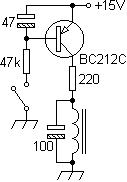
main buffer
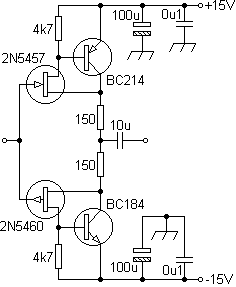
switched range Baxandall tone controls (opamps specified for these, the tape buffer and filter were TL072, LF353, LM833, OP27/37),
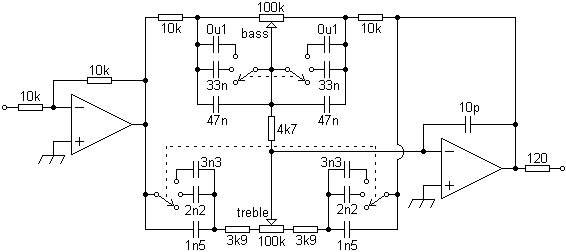
rumble filter (for calculations see above)
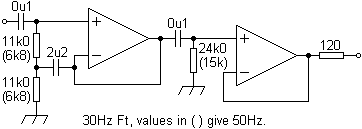
and the headphone amplifier.
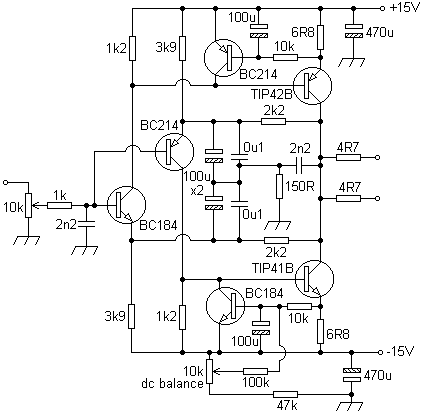
These and the Hart K2100 'Chiara' single ended class A headphone amplifier (below) could be run from a single regulated supply, the K3500 'Andante', via 9/25way D connectors. This comprised of two sets of 15V 78/9 series regulators (separate pairs for the preamp and headphone amp) with a separate 7815 for switching relays, smoothed by 2m2F, decoupled by 100µF. As with a number of kits (Hart and Powertran), mains filtering was poor.
Alan Jackson offers PCBs for this project at apj audio.
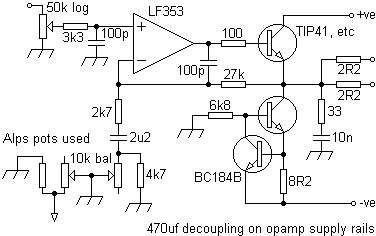
The 'separates' designs had PCB selectable ground options. If a ground is lifted, an HF path to chassis (capacitor) usually improves and is best made permanent.
Other interesting JLH circuits include a millivoltmeter,
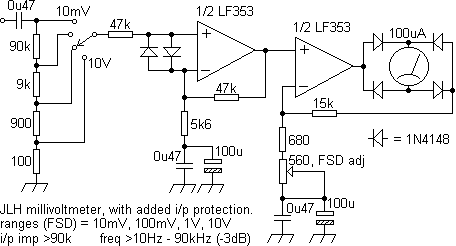
a moving-coil preamp and a symmetrical, low-distortion, gain block (circuit information for both courtesy of Michael Jonassen) detailed in 'Symmetry in audio amplifier circuitry', E&WW, Jan '85, pp31-34.
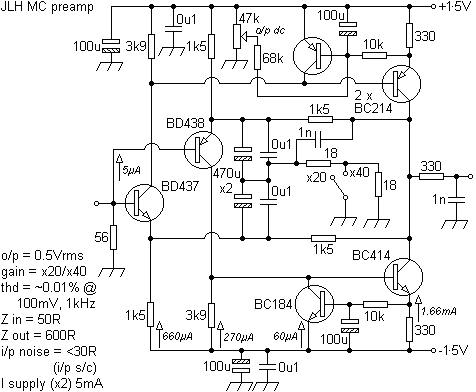
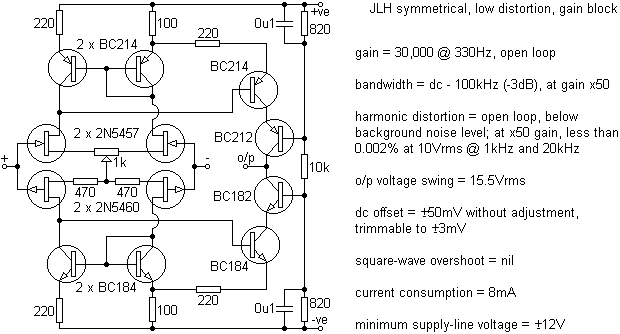
JLH simple class A, MOSFET and other RIAA designs
Google search for John Linsley Hood.
Contact me at paulkemble@hotmail.com
especially if you want additional content to this page
or if you find
any links that don't work. Don't forget
to add the page title or URL. Take care!
Back to index, sound, tips or home.





